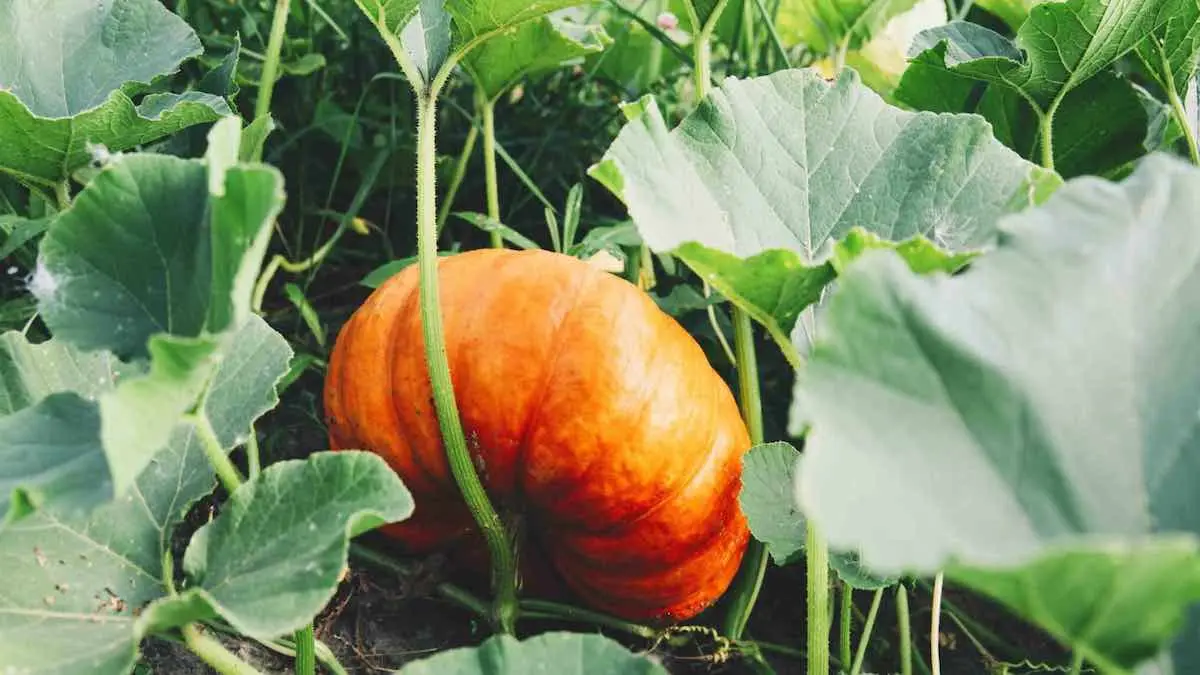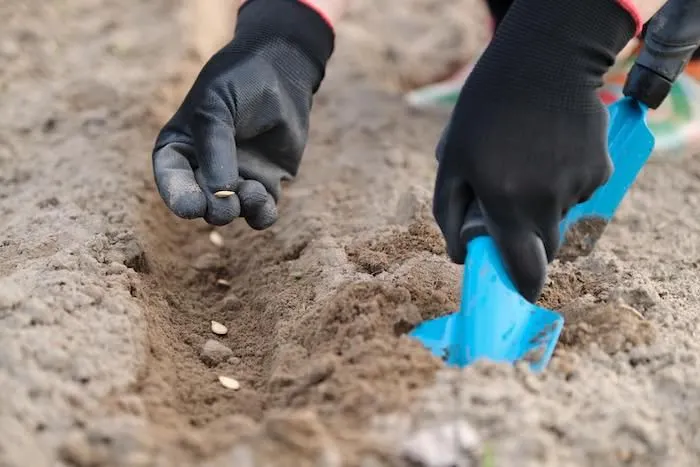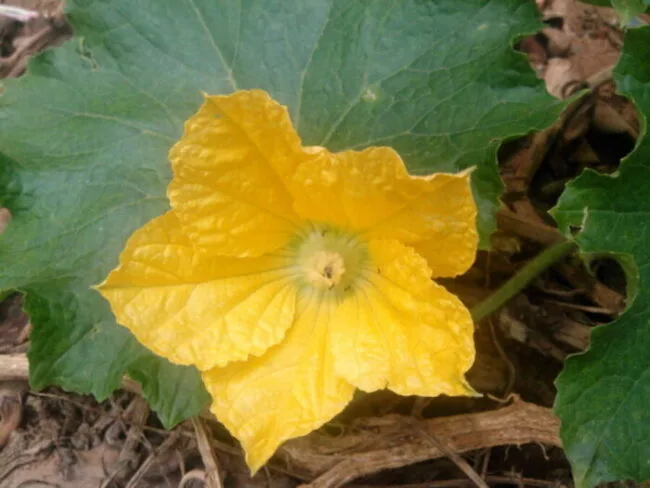Table of contents
Pumpkin Growing Season Australia
Grow pumpkin at home today to eat healthy and save money. Pumpkin is a member of the Cucurbitaceae or squash family. The plant originated in Central America thousands of years ago. Hence it is no stranger to the tropics.
There are over 150 separate species of pumpkin plants. Consequently pumpkin comes in every shape, colour, and size you can imagine.
In tropical regions of Australia pumpkin grows well in the cooler part of the year known as the ‘dry season’.
In the tropics, plant your seeds late in the wet season, or early in the dry season, water regularly, cheer on the bees and in a few months you can harvest.
Growing Kent Pumpkins in Australia
We grow the Kent (aka Jap) pumpkin, which does quite well in the tropics. It is a good choice for those looking to grow pumpkin at home.
Other varieties of pumpkins you can grow well in tropical areas include the Queensland Blue, Butternut and Buttercup.
Growing Pumpkins in QLD
Pumpkins grow over a large area, so make sure you have enough space. It is a really good idea to have a trellis for your pumpkin vines to grow up.
Because they grow so vigorously, a trellis will give them some direction and for the urban gardener, a trellis helps you to grow vertically, which allows you make the most out of your limited space.
Pumpkin does well in a good enriched soil. So add plenty of well-rotted compost and/or manure. In the tropics, it is a good idea to plant into raised mounds, so the soil will not remain too wet.
Growing Pumpkins from Seeds
Time needed: 3 minutes
How to grow pumpkin from seed.
- Collect seed:
Use the pumpkin seeds you have collected previously. If you are a new grower, the simplest and cheapest way to grow pumpkin is from the seeds of a supermarket bought pumpkin.
- Confirm site:
When your seeds are ready to plant, you can start them out in potting mix using seed trays and transplant them later. However, we plant ours directly into prepared ground where we want them to grow.
- Sow:
Plant your pumpkin seeds 2.5cm (1in) deep. One vine will cover around 3 metres (10ft), but always over-sow. If more seedlings germinate than you need, simply thin them out.
- Sun and Water:
Make sure you have planted your seeds or seedlings in an area that gets full sun, where you can water regularly.
- Prune:
Pinch out the ends of rambling stems to help contain growth (unless you have heaps of space).
Pollination to Grow Pumpkin at Home
You can hand pollinate your pumpkin, but if you have natural pollinators in your garden they will do the work for you.
Provided you have plenty of bees around and a number of flowering pumpkin plants, pollination will occur naturally.
How Many Pumpkins per Plant?
The number of pumpkins per plant that you can grow at home can vary widely depending on several factors such as the variety of pumpkin, growing conditions, care provided, and the size of the pumpkins desired.
On average, a single pumpkin plant can produce anywhere from 2 to 5 pumpkins. However, under optimal conditions with proper care, some plants can yield even more. It’s important to note that larger pumpkins generally mean fewer pumpkins per plant, as the plant’s energy is focused on producing one or two larger fruits rather than several smaller ones.
Growing Pumpkins in Pots Australia
Growing pumpkin in pots can be a rewarding experience, though it requires careful attention to ensure the plants have enough space, nutrients, and support to thrive. The basics remain the same, but here are three extra tips on how to grow pumpkins in pots:
- Choose the Right Pot:
Select a large container with a minimum size of 15 gallons (approximately 24-30 inches) in diameter. Pumpkins have extensive root systems and need plenty of room to grow. Ensure the pot has drainage holes to prevent water-logging, which can lead to root rot. - Select a Suitable Variety:
Choose a pumpkin variety that is well-suited for container gardening. Smaller or bush-type varieties tend to perform better in pots.
Some good options include ‘Small Sugar’, ‘Jack Be Little’, or ‘Baby Boo’. - Prepare the Potting Mix:
Use a high-quality potting mix that is well-draining and nutrient-rich.
Optionally, mix in compost or aged manure to provide additional nutrients.
By following these steps and providing proper care, you can successfully grow pumpkins in pots and enjoy the harvest of fresh, home-grown pumpkins.
Watering
Watering regularly is important, as most of your pumpkin growing will take place during the ‘dry season’ in the tropics. However, pumpkins do not like sitting in a puddle, so take care to get the balance right.
Fertilising
Apply a rich compost and/or well composted manure to the soil before planting. Fertilise regularly after your pumpkin seedlings emerge, but do not use a fertiliser too high in nitrogen. If you use too much nitrogen your pumpkin vines will become large, but not produce fruit.
Pests and Diseases
Hot and humid conditions make downy mildew a problem in the tropics. However, you can combat this by not overcrowding your pumpkins and by crop rotation.
An additional control method is to cut off old leaves that are yellow and dying to prevent mildew spreading from them to new un-diseased leaves. Neem oil is one organic solution you can apply. It will help to combat certain insects and fungal diseases.
Pruning
You don’t prune pumpkin for the sake of it. Thus you prune pumpkin for a purpose. Indeed this purpose may be encouraging growth, redirecting the plant, or removing disease or damage. Work out your objective and prune accordingly.
Never prune off more than 30 per cent of your leaves at one time.
Growing Pumpkins Vertically Australia
Growing pumpkins vertically is an excellent way to save space and improve air circulation. Here’s how:
- Choose a Sturdy Trellis: Use a strong trellis, fence, or A-frame structure that can support the weight of pumpkins.
- Select Smaller Varieties: Plant small or medium-sized pumpkins, like sugar pumpkins or Jack Be Little.
- Training the Vines: Guide and secure the vines to the trellis as they grow using soft ties.
- Support the Fruit: Use slings made of fabric or netting to cradle developing pumpkins, preventing them from breaking off.
- Water and fertilise regularly for healthy growth.
Grow Pumpkin at Home to Eat
Most of us grow pumpkin at home to eat or share wth friends. This is great, because eating pumpkin can have real health benefits.
Health Benefits
The reason we all grow pumpkin at home is to enjoy the harvest. In addition, consuming pumpkin has real health benefits.
Weight Loss
A number of studies have indicated that eating more plant foods such as pumpkin reduces the risk of obesity and obesity related diseases.
Fibre
Pumpkin are a wonderful source of fibre. Indeed, this is important as more fibre in the diet has been shown to help with weight loss, digestion and bowel function.
Immune System
Pumpkin is full of nutrients that will boost your immune system. Indeed these nutrients include vitamins, minerals and antioxidants.
Antioxidants
Furthermore, pumpkin contains beta carotene, which is an antioxidant that can help avoid some cancers and reduce the likelihood of some heart diseases.
Prebiotics
Pumpkin contains prebiotic fibre which helps beneficial microbes to populate the gut and bowel.
So, in light of these health benefits, now you know how to grow pumpkin at home, why not get planting?
Other Tropical Vegetables
- Capsicum
- Cucumber
- Eggplant
- Jicama
- Kangkong
- Malabar Spinach
- Pak Choi
- Perpetual Spinach
- Snake Beans
- Sweet Potato
- Tatsoi




Comments
2 responses to “Grow Pumpkin at Home: Your Guide.”
[…] Pumpkin Growing […]
[…] Pumpkin Growing […]